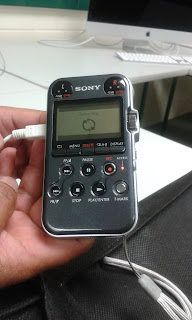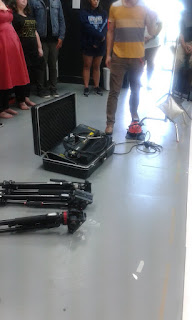Sound Recording
This is a Zeplin!!Say hello to him!!
Sound is directional - Faint/Loud, (dead cat) stops wind noise, microphones sensitive to sound and touch.
Boom Pole - Closer to the source the better.
Right environment, quiet space, realising what a loud world we live in
Low frequency - Traffic

Folley Artists - someone re-create afterwards, recording studio, different textured stones edit>sound recording a scene or two just recorded. Completely recorded on the day. There is alot to recording sound
Wikipaedia Definition of Foley Artists
Foley is the reproduction of everyday sound effects that are added to film, video, and other media in post-production to enhance audio quality. These reproduced sounds can be anything from the swishing of clothing and footsteps to squeaky doors and breaking glass. The best Foley art is so well integrated into a film that it goes unnoticed by the audience It helps to create a sense of reality within a scene. Without these crucial background noises, movies feel unnaturally quiet and uncomfortable.
Foley artists recreate the realistic ambient sounds that the film portrays. The props and sets of a film often do not react the same way acoustically as their real life counterparts. Foley sounds are used to enhance the auditory experience of the movie. Foley can also be used to cover up unwanted sounds captured on the set of a movie during filming, such as overflying airplanes or passing traffic.
The term "Foley" is also used to describe a place, such as Foley-stage or Foley-studio, where the Foley process takes place.
1. Make sure environment quite
PCM Recorder (digital)
Recording Audio with the PCM recorders and
Sennheiser Microphones
1. Put together the Sennheiser microphone...
1. Put together the Sennheiser microphone...
2. S et up the rest of the audio equipment. The boom pole will slide into the bottom of the
microphone pistol grip.
3. Power up the PCM recorder by sliding down the power button for at least 3 seconds.
4. Set the PCM to ‘ Manual’ recording mode and plug in the headphones. Make sure you plug
into the headphone jack. There are multiple jacks on this unit, so it can be confusing.
5. Make sure your Headphone volume is set to 15, so you are getting the right audio level in your headphones. (You don’t want the signal to be too loud or too quiet).
6. Set the Microphone recording level to either ‘ Hi’ or ‘ Low’. You’d typically record at a low level if you were recording a rock concert or heavy traffic etc. For most situations interviews, drama, etc you’d probably set this to ‘ Low.’
5. Make sure your Headphone volume is set to 15, so you are getting the right audio level in your headphones. (You don’t want the signal to be too loud or too quiet).
6. Set the Microphone recording level to either ‘ Hi’ or ‘ Low’. You’d typically record at a low level if you were recording a rock concert or heavy traffic etc. For most situations interviews, drama, etc you’d probably set this to ‘ Low.’
7. P ress the record button (1). You should hear the audio through your headphones
WARNING: IT IS NOT RECORDING YET. YOU HAVE ONLY ARMED IT TO RECORD.
You must now press the pause button (2) to start recording.Y ou will see ‘REC’ on the display
You must now press the pause button (2) to start recording.Y ou will see ‘REC’ on the display
8. Adjust the silver volume dial until the audio levels on the meter are on average coming in at
12 to 10 db
TROUBLESHOOTING:
You can’t hear any audio:
You can’t hear any audio:
-
Are your headphones plugged into the correct jack?
-
Is your headphone volume turned right down?
-
Have you pressed the record button? (You will not hear audio unless you have).
-
You possibly have a faulty cable try another XLR or XLR to mini
-
Is the microphone turned on? Perhaps the microphone battery is dead?
Sound compact
Counter balances
Level essentially
Distortion
Microphones used to be formatted like cameras.




















